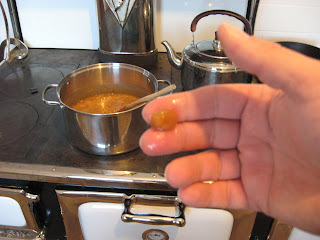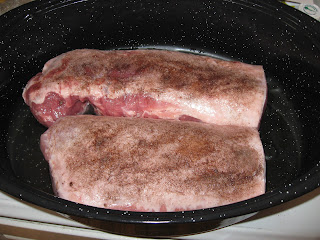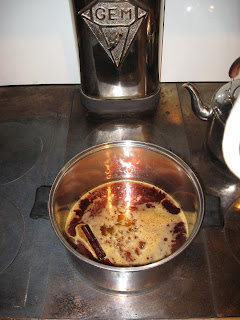Well, I've gone and done it again. Grandma told me that I shouldn't do it, but I disobeyed her and did it anyway. The process was gruesome, and the results were...hmmm...let's say "undesirable." But it is finished, and I 'm glad it's over. Yes indeed, I have made the suet pudding.
Before I go any further with this post, I feel that it is necessary to put a few disclaimers here in the beginning:
1) What you are about to read is true to the best of my knowledge. Yes, it is sprinkled with a great deal of my own unfavorable personal opinion, but I'm being honest here, folks.
2) No matter what I may write here, I mean no disrespect to my elders, ancestors, or forebears, nor their elders, ancestors, forebears, and kin, no matter how poor their culinary preferences may have been.
3) No matter what I write here, I mean no disrespect to anyone who enjoys this sort of food. I'm just too narrow minded to understand it.
4) Finally, I'd like to apologize for including this recipe on my blog. I try to present foods here that I think are good. This is a complete departure from that focus.
Perhaps some of you are wondering what in the world suet is. Suet is the fat which is found around the kidneys of cattle, and it is where beef tallow comes from. It is also the stuff that some of my family members have been making Christmas pudding out of for as long as anyone living or dead could remember. My grandma's grandma made this pudding every year at Christmas. Her maiden name was O'Donald, and she was Scotch-Irish. I don't know whether her Scotch-Irish ancestors made this pudding, or whether it was a responsibility that was foisted on her by her husband's family whose surname was Ford. My copy of the recipe is labeled "Ford's Suet Pudding," so I'd like to believe that Grandma (O'Donald) Ford, whom my own grandmother has romanticized into the epitome of grandmotherdom, is not the person who is responsible for this gastronomical travesty. Either way, the recipe obviously originated in the British Isles, and I imagine it is chief among the reasons that the English are not generally revered for their cuisine.
I did a little research before writing this post and confirmed my suspicion that what we have always called suet pudding is the same as plum pudding, which is a very close cousin to the "figgy" pudding mentioned in "We Wish You a Merry Christmas." For some droll and informative reading about this historic dessert, I recommend visiting this site about
figgy pudding and this site about
plum pudding. The first site mentions the "interminably long" cooking time for these puddings and notes that they are steamed because this method was "very popular in the days before regulated heating." Sounds like a recipe that is tailor-made for the woodburning cookstove, doesn't it?
My grandma still has and uses the kettle that Grandma Ford used to steam this pudding on her wood cookstove many years ago. After Grandma Ford, my great-grandma Gladys made the pudding. She passed away in 1975, and then my grandma took up the job. Grandma taught me how to make it, not because I like to eat it, but because--as anyone who knows me will concur--I am interested in tradition. Grandma has retired from making the suet pudding, but I have taken up the job in the interest of giving my great-uncles an annual taste of their childhood.
I have to say, though, that my tenure as the pudding maker is probably destined to be fairly brief because I don't think that anyone in the younger generations much cares for this stuff. I've introduced it to friends and in-laws on Nancy's side, and I have yet to run across anyone who likes it--and I can totally understand why.
To commit this heinous bit of cookery, the first thing that you must do is locate some suet. Unfortunately, both of our local meat markets are more than willing to part with the stuff. Judging from the price that they charge, demand is not very great. Some years, they have just given it to me free with an expression on their faces which causes me to suspicion that they have tasted this pudding and feel pity for anyone who has judgment poor enough to willingly make it on his own. The recipe only calls for a cup of suet, but once you see the stuff, that seems like way too much.
This cup of suet is ground together with a cup of currants and a cup of raisins. My grandma likes to use golden raisins to prevent the pudding from being so dark.
I am a raisin lover--have been since I was a toddler--and this seems to me a cruel thing to do to a raisin.
Grandma told me that the pudding is improved (as if that were really possible) by grinding this mixture three times. She almost always did this by hand, and I have done it by hand, but I have to tell you that it is work. This is a thick, sticky mess. The worst problem with this process, though, is cleaning the grinder afterward. Grandma's hand grinder is from the days when Methuselah was a teenager, but it is cleverly engineered and opens up for easy cleaning. Mine does not, and getting the last remnants of this sludge out of it is not easy. Therefore, I don't regret using my Goodwill Warehouse grinder, even though it is electric.
 |
The raisin, currant, and suet mixture after three grindings. You
don't need to tell me what it looks like. Trust me, I already know. |
To the ground fruit and fat mixture, you add 1/2 c. molasses, 1 c. brown sugar, 1 1/2 cups sour milk, 2 1/2 c. flour, 1 tsp. salt, 1 1/2 tsp. soda, 1 tsp. baking powder, 1 tsp. nutmeg, and 1 tsp. cloves.
 |
Because the ground fruit and fat mixture is so
sticky and difficult to incorporate, Grandma
always used her mixer for this task.
|
 |
| The complete mixture. Don't say it. I know what this looks like, too. |
I'm sure that my great-great grandmother probably put this pudding into some sort of metal mold and then steamed it in the big kettle. I understand that originally it would be suspended from a cloth bag along the side of the large iron kettles in which the English would cook their entire meal simultaneously. However, we grease a few metal food cans and fill them halfway full. I also used a wide mouth pint jar successfully.
 |
| The pudding ready to be covered with foil and steamed. |
I cover these with foil and then steam them in our little water bath canner. To steam in this fashion, you just have to have about an inch and a half of boiling water in the bottom of the canner. The puddings rest on the jar trivet in the water. The original recipe says to steam for three hours. This would be necessary if the pudding were all cooked in one container. Since we cook it in small cans so that it can be easily divided among those who will receive it, steaming for an hour and a half is all that is needed.
Remove from the steam when they are done. The cooked pudding keeps in the refrigerator indefinitely.
As if the pudding weren't bad enough, when you go to serve this, you are supposed to pour a little hard sauce over it. I'm not a fan of hard sauce either. To make it, you cook 2 cups of water, 1/2 cup sugar, and 2 Tablespoons of cornstarch together until it is thick, stirring pretty much constantly. Grandma Gladys always put a tablespoon of butter into this as it cooked also (terrible waste of good butter, in my opinion). When it has thickened, you remove from the heat and add a 1/4 tsp. of lemon flavoring and a dash of nutmeg.
 |
Perhaps if you click on this picture to enlarge it, you can see the
sauce better. This plate belonged to Grandma Gladys and has very
likely held suet pudding in years past. |
There you have it: Ford's Suet Pudding, our family's traditional Christmas "treat." All I can say is, you've been fairly warned.














































